1. Jimmy Connors, 1991 US Open
The eight-time Grand Slam winner had already caused a stir at Flushing Meadows before his fourth-round match with the top-10 ranked Aaron Krickstein. That an ageing Connors had gone so far as a wildcard was a truly remarkable feat in itself. He was the world No 174 going into the tournament; a brief cameo was about as much as anyone expected.
But it is testament to his fighting spirit and no little skill that Connors was able to knock over a collection of talented young opponents on his way to what would be a titanic tussle with Krickstein on Stadium Court on his 39th birthday. Having lost the first set, Connors fed off the support of the vociferous Labor Day crowd to mount a fightback in the second, forcing a tie-break and flooding his veins with Incredible Hulk levels of testosterone.
It was here that a bad call led to him blowing his top in spectacular style. “He called the ball good, you didn’t see the God darn ball,” yells Connors, having scurried towards the umpire David Littlefield’s chair like an irate Yorkshire Terrier. “It was clearly out,” counters Littlefield. “Clearly bull crap! Bull crap!” is Connors’s reply, his worst volley of the day by a country mile.
It soon became clear that Connors had perhaps gotten a little carried away with his own underdog story. “I’m out here playing my butt off at 39 years old and you’re doing that! Get your ass out the chair! Get your ass out of the chair! You’re a bum! You’re a bum!” Remarkably, Connors wasn’t sanctioned for the abuse, which included Littlefield being called an “abortion” among other things. The reason? The umpire chose not to report him.
Connors was well known for putting pressure on umpires and was often accused of bullying – perhaps here his tough-guy image helped him avoid a fine or worse. He kept up his bullish Captain America antics, going on to beat Krickstein in five sets, having trailed 5-2 in the last. "Happy birthday to you," sang the crowd on Stadium Court. Perhaps that's all Connors wanted – a bit of credit for flying the flag for middle-aged men.
He was finally made to look his age by Jim Courier, 18 years his junior, in the semi-finals, being beaten in straight sets. Connors had made his last big noise at a Grand Slam. A thoroughly entertaining and furious one. – Gregg Bakowski
2. Jeff Tarango, Wimbledon 1995
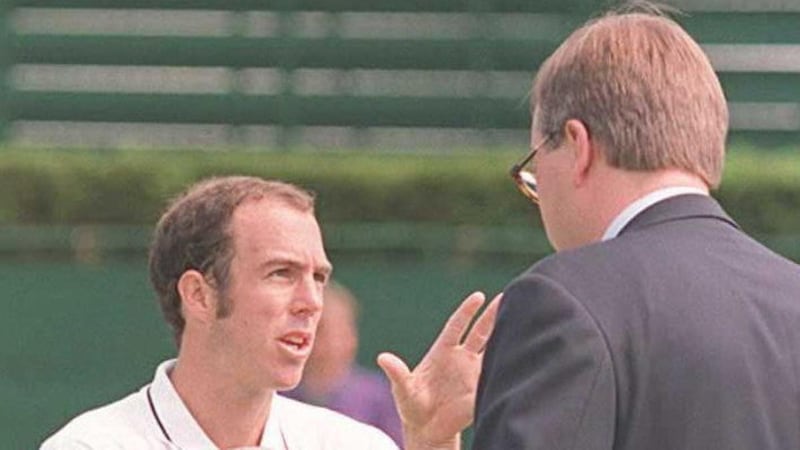
With a name like Jeffrey Gail Tarango, Jeffrey Gail Tarango was always likely to understand ire. And at Wimbledon in 1995 he proved it as both provokee and provocateur, turning humdrum into historic amid the kind of scenes that no one wants to see, that everyone with a soul is desperate to see.
In the first round of the doubles he and his partner, Henrik Holm, were two sets to one down against the local favourites Tim Henman and Jeremy Bates. Playing a third-set tie-break, Henman became upset after losing a point to a net-cord, so belted a loose ball only to crack a 16-year-old ball girl in the side of the head. Down she went, crying. Naturally, Tim was tigerish in his compassion. "There's hard and very hard," he told the umpire, "and I hit the ball hard. It wasn't as if I bulleted it, and she's standing there and she runs straight across in front of me." People doing their jobs without regard for the childish petulance of others; disgusting.
Tarango, meanwhile, smelled the sweet scent of opportunity. "With the speed of the ball, it could have killed the girl," he piously observed, as the tournament referee appeared on the scene. Amazingly, even Henman's display of first-name terms could not save him, and Alan Mills duly defaulted him. It was a desecration of everything that Wimbledon represents.
A few days later, Tarango played Alexander Mronz in the third round of the singles. Finding himself 6-7, 1-2 and break-point down, he was denied an ace when a line judge called a fault – only for the umpire to overrule and declare a let. This was ill-received. "No, that was an ace," he insisted. It was not, said the umpire. "No, it was an ace." It was not, said the umpire. "Nonononononono, I've seen it on TV a million times, that was an ace."
At this point, the most passionate and knowledgeable crowd in all of sport was forced to intervene. Its legendary sense of fair play had been mortally wounded by Tarango's intervention earlier in the week so, cognisant of the opportunity to incite some serious entertainment, it began to heckle with shouting, laughter and ilk. "Oh shut-up" was Tarango's tame response, prompting Bruno Rebeuh, the umpire, to demand some attention of his own. "Code violation," he announced. "Audible obscenity, Mr Tarango."
As the crowd cheered further, Tarango approached the chair. “How is that an audible obscenity,” he queried, with good reason. “Well how come they can say whatever they want to me?” he continued with teenage logic. After which he reverted to call centre tactics. “Can you call a supervisor please?” he asked Rebeuh. “I have a big beef.”
Rebeuh was reluctant, but Tarango was robust. "No no no, I'm not playing any more," he said. So out came Stefan Fransson, who told Tarango to get on with it. So Tarango got on with it. "You are the most corrupt official in the game and you can't do that!" he told Rebeuh, earning another code violation for verbal abuse, this time with a point penalty. The game was gone and so, probably, was the set. "That's it. No way! That's it!" he ranted to increasing mirth, slamming down the balls in his hand and making the finished gesture. He then grabbed his bag and stalked off court, the first person so to do in 109 years of Wimbledon history.
Rebueh, of course, snared the last word, defaulting Tarango who, by the press conference, was calm and focused. There, he explained a conspiracy whereby Rebeuh favoured certain players in return for the gift of their friendship, information gleaned from two women Rebeuh had tried to pick up at a party.
Tarango did, though, admit regret at stomping off, before hinting at something more elemental. “I don’t feel that I should be pushed around for my whole life and let people take advantage of me,” he said. “I just felt that I was backed into a corner and that I had no recourse for defending myself.”
Mrs Tarango did not bother with such prevarication, simply slapping Rebeuh across the face, twice. “I don’t think it’s bad,” she said. “I think it’s good, because this guy deserves a lesson at some point. He can do whatever he wants because he’s in the chair. It’s just not fair.”
“Well, you know,” explained her husband. “Women are emotional.” Unlike, of course, Jeffrey Gail Tarango. – Daniel Harris
3. Serena Williams, US Open 2011
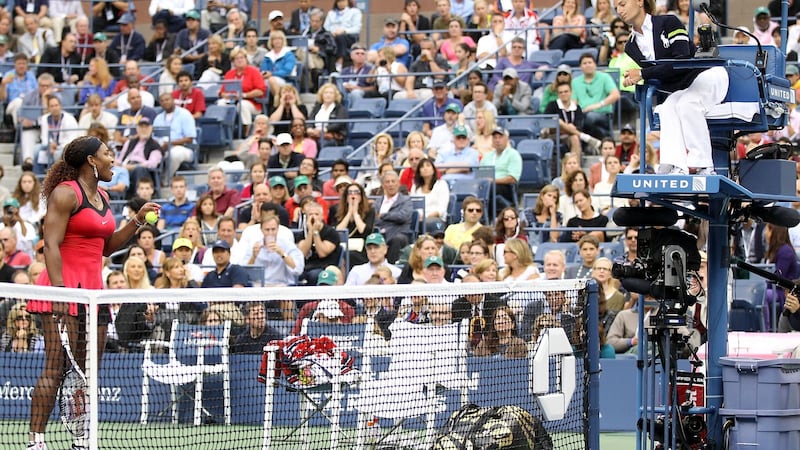
There is absolutely loads to be said for generic, foul-mouthed rage. Consider, say, Andy Murray splashing bad words all over Adel Aref, a moment of honesty and simplicity so pure as to be almost moving. But the technique is effective only in the moment, an explosion without depth charge – no subject is likely to wonder about themselves thereafter. But the focused, discursive meltdown – that is another sport entirely, and a far less comfortable one too.
In the 2009 US Open, Serena Williams was 4-6, 5-6, 15-30 and second serve down to Kim Clijsters, whereupon she was foot-faulted. This forced her to remonstrate with the offending line judge. "I swear to God I'll f**king take the ball and shove it down your f**king throat," she offered. So far, so unimaginative, but the line judge grassed to the umpire anyway, the umpire grassed to more senior officials, and she was duly disqualified.
Two years later, Williams faced Samantha Stosur in the final. This time, she found herself a set and 30-40 down, saving break-point with a dazzling forehand winner. "Come on!" she hollered – a nanosecond before Stosur tried to return it, and though that was never happening, the touch of racket on ball was enough for her to be deemed put off.
"It's her point," said Eva Asderaki, the umpire. "I don't understand," Williams replied. "Because when you called out, she got distracted," came back the explanation. "Then maybe you should replay the point," advised Williams. "I'm not giving her the game."
But Asderaki was steadfast. “This is not a replay,” she insisted. “It’s her point because when you shouted she went to the ball and touched the ball.” At which point things took a turn for avant-garde. “Are you the one that screwed me over the last time here?” asked Williams. “You’re nobody. You’re ugly on the inside.” Ouch.
And that was not it, either; barely had Asderaki time to ponder these profound existential issues before Williams was at her again. “We were in America last time I checked,” she said at changeover. “Don’t look at me. If we’re ever walking down the street, stay on the other side. You’re totally out of control. You’re a hater and you’re unattractive inside. What a loser.” Gulp.
Though Williams broke back immediately, Stosur won the match 6-2, 6-3. Afterwards, Williams was unrepentant, refusing to cow before those keen to judge her without a clue what it was like to be her. “I was in a zone,” she said. “We live for these moments.”
Moments that were, in this case, indisputably awkward, unpleasant and unkind. But who can say with certainty that they would have handled them differently? – Daniel Harris
4. Jerzy Janowicz spits on the line, Australian Open 2013
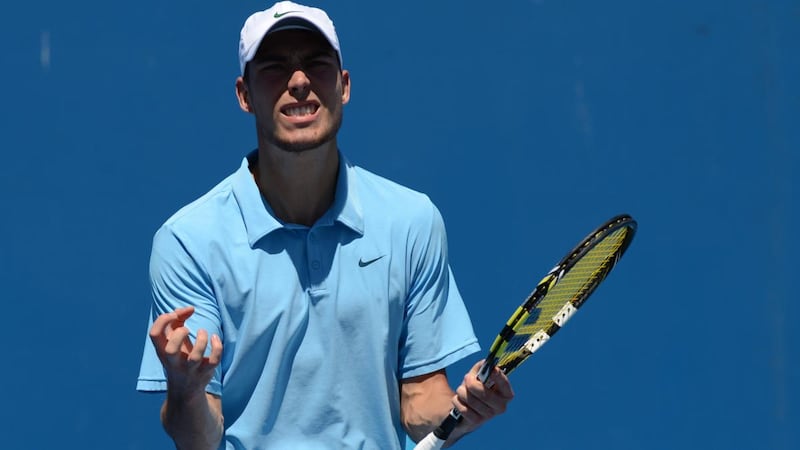
Who else remembers the Wimbledon final between Novak Djokovic and Jerzy Janowicz in 2013? No one, that's who. It never happened. But it almost did. The first Polish man to reach the last four of a Grand Slam event, Janowicz won the first set on a tie-break in his semi-final against Andy Murray, dropped the second and led by a break midway through the third. Denting Murray's armour with his huge serves, and mixing up his power play by throwing in the odd drop shot here and there, he looked in control of the match.
But if anyone had reached that conclusion as the light over Centre Court gradually faded, they hadn’t reckoned with Murray’s relish for a stirring comeback. It arrived, inevitably and the Scot swept into the final in typically obdurate style, although not without the controversy of a disagreement about the roof at the end of the third set. Janowicz wanted it on and argued his case vociferously, saying that he was struggling to see the ball as darkness fell, while Murray wanted to maintain his momentum. The Pole won that battle, but lost the match, and he did not endear himself to the crowd with some of his antics, that deep frown of his lending him a menacing air.
Janowicz was an emotional presence on and off court in those days, weeping with joy during a live television interview after reaching the final of the Paris Masters in 2012, attracting derision when he delivered a petulant underarm serve during a match at the US Open.
His most memorable outburst, however, came at the Australian Open in 2013 and it was a classic of the genre, a hot blast of steam brought on by a tight line call going against him during a tense tie-break with Somdev Devvarman. Enraged when Devvarman saved a set point with a winner that looked out, Janowicz let rip, making a name for himself with the sheer showmanship of his tantrum. “How many times?” he roared. “How many times?”
Briefly it seemed that he was about to grab a microphone and launch into a power ballad, which probably would have been preferable to what happened next, as he gobbed in the general vicinity of where Devvarman’s shot had landed. Off-putting though spitting is, it was difficult not to see the funny side of the melodrama and utter ludicrousness of Janowicz taking out his frustration on an inanimate object that way. If a branch had been close by, it sends a shudder down the spine to think of the thrashing the blue concrete would have received.
Janowicz lost the tie-break, a development he accepted in predictably good humour. He hit the umpire’s chair and tossed a water bottle across the court. Although he fought back to win the match, he was fined €1,700 for his behaviour. “I went nuts,” Janowicz said. – Jacob Steinberg
5. Andre Agassi, US Open 1990
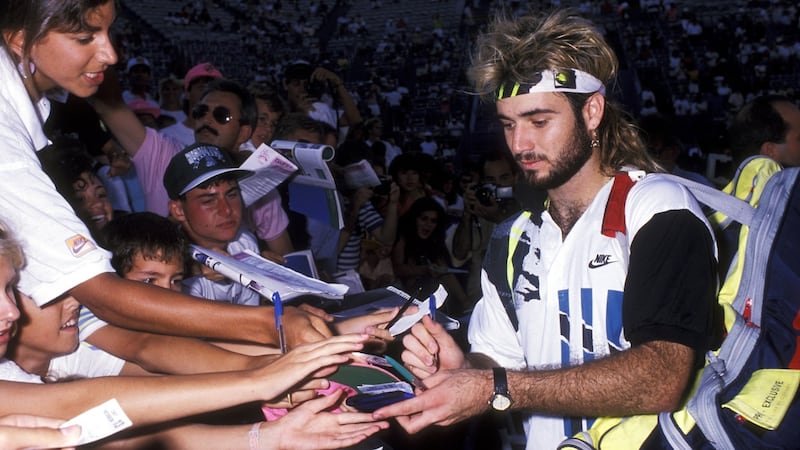
When Andre Agassi declared "image is everything" in a 1991 Canon Rebel camera advert – in which he spent most of his time running his hands through his mullet while driving a Jeep and spinning his racket on his finger against the backdrop of a mountain range – it wasn't necessarily unusual for AA MK 1, though the timing certainly was.
At 21 years old, Agassi was among the best-paid players in the game, but had yet to win a Grand Slam – in fact he had just lost three finals on the bounce and had refused to appear at Wimbledon for the third year running because of the dress code – so this was perhaps an odd time for another declaration of style over substance. Agassi’s slogan and the advert were also odd for featuring almost the exact outfit – cropped lime, black and white shirt, matching headband, gold jewellery – that he had worn not a year earlier at the US Open, in which he spat and cursed at an umpire.
In his second-round match against Petr Korda, and in front of a live TV audience, Agassi lost it. After a shot of his was called out, tennis's biggest star marched towards the umpire Wayne McKewen and impolitely asked: "Are you bullshitting me?" before turning on his heels with an ill-timed "f**k!" as he retreated back to the baseline. A code of court violation was issued by McKewan, causing Agassi to repeat his journey to the chair, this time wailing at point-blank range with all the protestation of a young boy that knows he in the wrong: "I didn't say anything! I didn't say anything . . . you son of a bitch!"
Agassi was lucky that McKewan somehow didn't hear this last self-defeating utterance but at the next changeover, on his way to his own chair, Agassi spat, with his saliva landing on McKewan's leg and foot. Immediately the umpire called tournament director Ken Farrar out on to court. "Spit on you? No. It was an accident, really," explained Agassi. "Here, do you need a towel?" Farrar gave Agassi the benefit of the doubt and issued no penalty but later saw the condemning footage that changed his mind. "I made the mistake of not being out on court, because when I went out, the situation was very serious and I was flying a little bit blind. I gave the player the benefit of the doubt because I hadn't seen what had happened. After I saw the tape, I realised I shouldn't have done that. It's clear from the tape that he spit in McKewen's direction."
Agassi went on to win in four sets but received a fine of $500 for his swearing and $2,500 for the spitting. After victory in his next match, he appeared unrepentent: “The whole thing wouldn’t have happened if the umpire had been doing his job.” – Michael Butler
6. Andy Roddick, Australian Open 2008
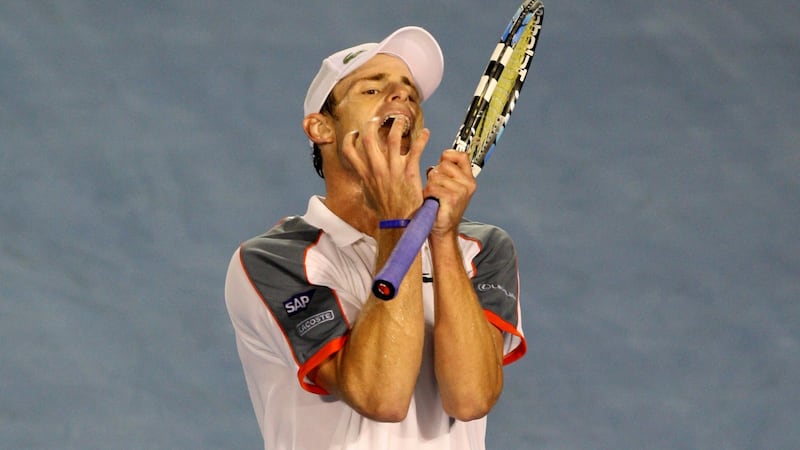
There was, indeed there still is, a lot to like about Andy Roddick. He is a fabulous pundit these days, sharp of tongue, quick witted and insightful. When he first broke through in 2003, with all the impish recklessness of Steve Stifler, he instantly became the darling of the media, becoming the youngest American No 1 since records began after 140mph-serving his way to the US Open in 2003.
But by 2008, the wheels had started to come off: still marooned on one Grand Slam title, 2007 had been an injury-blighted year and at the beginning of the next at the Australian Open, public opinion soured when he not only made personal insults against an official, but undermined the entire umpiring profession.
It had been a frustrating night for Roddick. By the end of it, the sixth seed would depart the Rod Laver Arena after 2am, defeated by the 29th seed Philipp Kohlschreiber despite serving a then career-best 42 aces. The umpire Emmanuel Joseph bore the brunt of it, and after an overturned out call, Roddick let rip with all the explosiveness of a forehand. "You're an idiot. You're lying to yourself. Seriously, do you have to be like a second-grade dropout to be an umpire? Did you go to school until you were eight years old? I think you quit school before you were 10." Then he addressed the jeering crowd, shouting at the top of his lungs: "Stay in school kids or you'll end up being an umpire!" – Jacob Steinberg
- Guardian service















